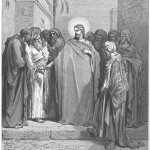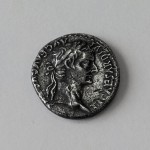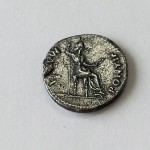Caesar’s Denarius
It is worthwhile paying thorough attention to one enlightening and meaningful story from the Bible. It is a story about Caesar’s denarius. This story happened back at the time when Jesus Christ was preaching in Jerusalem, and it is narrated in three Gospels. In the Gospel of Mark it is in chapter 12, verses 13 through 17; in the Gospel of Luke – chapter 20, verses 22 through 26; and in the Gospel of Matthew – chapter 22, verses 15 through 22.
My friends from Israel saw to it that there would be a “Caesar’s Denarius” in my collection also. And this is how the story proper goes.
«Then the Pharisees went out and laid plans to trap Him in His words. They sent their disciples to Him along with the Herodians. “Teacher,” they said, “we know that You are a man of integrity and that You teach the way of God in accordance with the truth. You aren’t swayed by others, because You pay no attention to who they are. Tell us then, what is Your opinion? Is it right to pay the imperial tax to Caesar or not?”But Jesus, knowing their evil intent, said, “You hypocrites, why are you trying to trap Me? Show Me the coin used for paying the tax.” They brought Him a denarius, and He asked them, “Whose image is this? And whose inscription?”“Caesar’s,” they replied. Then He said to them, “So give back to Caesar what is Caesar’s, and to God what is God’s.”When they heard this, they were amazed. So they left Him and went away.»
(Gospel of Matthew 22:15-22)
Jesus was surrounded by inquiring Pharisees and Herodians. They always fought between themselves. Pharisees stood up for the “purity” of the people and resisted any dictatorship on the side of Romans; but the Herodians, as it is seen from their party’s name, supported Herod the Great who was appointed by Romans, and favoured Roman authority. Therefore, two expected answers of Christ could and would provoke immediate anger, or even fiercer actions from either one of the two parties.
The answer that was heard by the questioners amazed everyone, «Give back to Caesar what is Caesar’s, and to God what is God’s». The words of the answer are especially significant because those were the last words spoken by Him in His teaching concerning the Kingdom of God on earth.
The Greek word δηνάριον (dēnarion) is used in the original text. It is traditionally believed that it was a Roman denarius with the image of the reigning emperor of that time – Tiberius. Among coin collectors it is commonly accepted that this very “Caesar’s denarius” (tribute penny) was a coin with Tiberius’ image and an inscription, «Ti[berivs] Caesar Divi Avg[vsti] F[ilivs] Avgvstvs» (Tiberius Caesar Augustus, Son of the Divine Augustus), and a seated woman – probably, Livia, depicted as the goddess of peace – Pax.
However, it has been suggested that denarii were not in common circulation in Judaea during Jesus’ lifetime and that the coin may have instead been an Antiochan tetradrachm bearing the head of Tiberius, with Augustus on the reverse. Another suggestion often made is the denarius of Augustus with Caius and Lucius on the reverse, while coins of Julius Caesar, Mark Antony and Germanicus are all considered possibilities, because coins of the previous rulers may also have been used in circulation.



